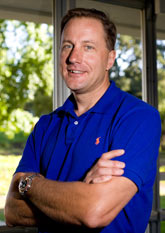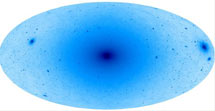

Friday - July 17, 2009
SLAC Today is
available online at:
http://today.slac.stanford.edu
In this issue:
From the SLAC Site Office Manager: Conservation of Energy
Dark Matter May Be Brighter Than Expected
BaBar Physicist to Receive EPS Young Particle Physicist Prize
 |
 |
|
Friday - July 17, 2009 |
From the SLAC Site Office Manager: Conservation of Energy As the SLAC Site Office, SLAC, and Stanford University grow our relationship and develop more trust, interactions between our organizations can become less episodic and more productive. We should over time have fewer meetings, shorter meetings, and spend less time and effort developing paper, writing reports and generating processes not central to our mission. After all, we are here to do science. Everyone's life is full of transactions—from buying groceries to waiting for airport security. Supporting SLAC science also requires transactions—things done as a necessity, activities that support the lab's mission…but at the end of the day are not the mission itself. As a Laboratory, we need to understand and minimize the amount of time and energy each transaction consumes so that we can put as much time and energy as possible into our mission work. Read more... Dark Matter May Be Brighter Than Expected Simulated all-sky map showing a galactic dark matter
halo in dark blue. (Image: Science).
The Fermi Gamma-ray Space Telescope might be able to find dark matter in our galaxy, and soon, if new predictions prove true. Theoreticians have demonstrated that small clumps of dark matter in our galaxy and others like it may be more visible than previously thought. Dark matter particles orbiting within self-bound clumps tend to move slower than those bound only to the larger halo that wraps around the entire galaxy. As a result, these smaller halos may generate a higher flux of gamma rays. If the theory is on target, the Fermi telescope could detect hundreds of small dark matter halos in the Milky Way alone. But, according to the authors of the paper in this week's Science, even a negative result will move the work forward. Researchers are still uncertain exactly what dark matter is, but a predominant theory suggests it is made up of supersymmetric particles that act as their own anti-particles. While dark matter does not emit or reflect light, the subatomic particles can annihilate each other—leaving behind a wreckage of subatomic detritus that may subsequently decay into gamma rays and reveal the location of the otherwise invisible matter. Read more... BaBar Physicist to Receive EPS Young Particle Physicist Prize Maurizio Pierini. (Photo: CERN.)
Physicist Maurizio Pierini will receive the European Physical Society's Young Particle Physicist Prize on Monday, July 20, in recognition for work he did as a member of the BaBar collaboration. Pierini studied the behavior of matter and antimatter by looking at the decays of B mesons produced in BaBar collisions. Comparing the observed decay rates with those predicted by the Standard Model of Particle Physics, he was able to confirm the existing theory and to constrain the presence of hypothetical new physics. The Young Physicist Prize is given once every two years to a physicist 35 or younger for outstanding work in high-energy physics or astrophysics. This year's award ceremony will take place at the upcoming EPS conference in Kraków. Pierini will share the prize with Fermilab physicist Niki Saoulidou. "I was not expecting it," Pierini said of the award. "It's a very, very good way of closing a long period of my life spent at SLAC. This is a nice way to close this wonderful experience." He emphasized that the award does not as much reflect his own efforts as it does the strength of the BaBar collaboration as a whole. "It was the environment we were working in that was the real success." Pierini started working on BaBar in 2000 as a doctoral student at the University of Rome. He continued on the project until 2007, during postdoctoral fellowships at the Linear Accelerator Laboratory in Orsay, France, and the University of Wisconsin. He is now working as a staff member on the Compact Muon Solenoid Detector at CERN. According to physicist Fernando Ferroni, who worked closely with Pierini at the University of Rome, the award is well deserved. "It shows the quality of the physicists who are working for BaBar," Ferroni said. "For me it is a pleasure to see that one, possibly the brightest, amongst young PhDs I supervised in BaBar received such a clear acknowledgment of the quality of his work." BaBar spokesperson Francois Le Diberder said that Pierini’s award is a striking illustration of how blessed BaBar has been with highly talented doctoral students and postdoctoral fellows. |
Events
Access (see all)
Announcements
|
|
| | ||
|
|
||
 <%
Response.AddHeader "Last-modified", getArticleDate()
'Response.AddHeader "Last-modified","Mon, 01 Sep 1997 01:03:33 GMT"
'Monday, December 06, 2010
%>
<%
Response.AddHeader "Last-modified", getArticleDate()
'Response.AddHeader "Last-modified","Mon, 01 Sep 1997 01:03:33 GMT"
'Monday, December 06, 2010
%>View online at http://today.slac.stanford.edu/. |
||